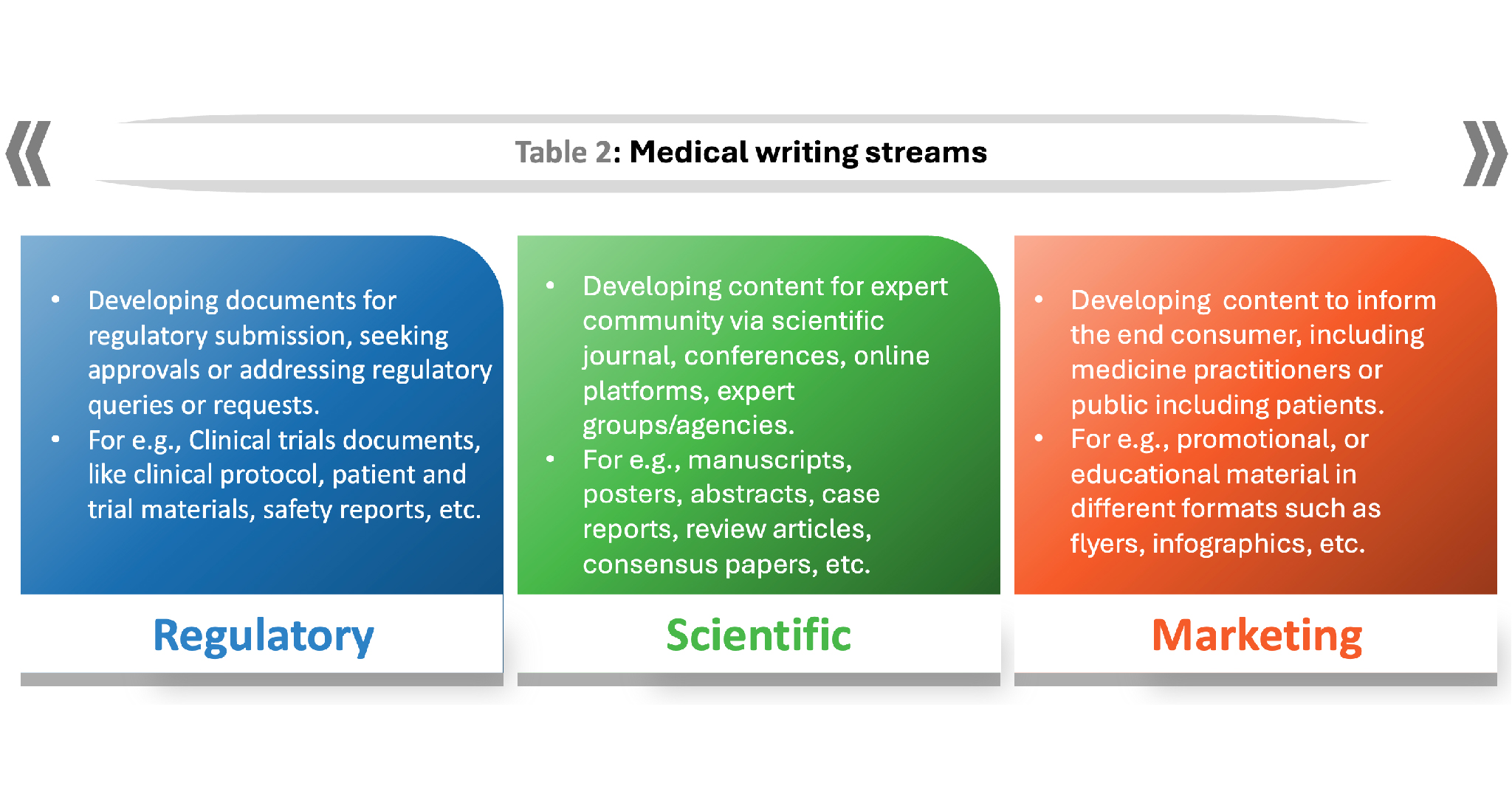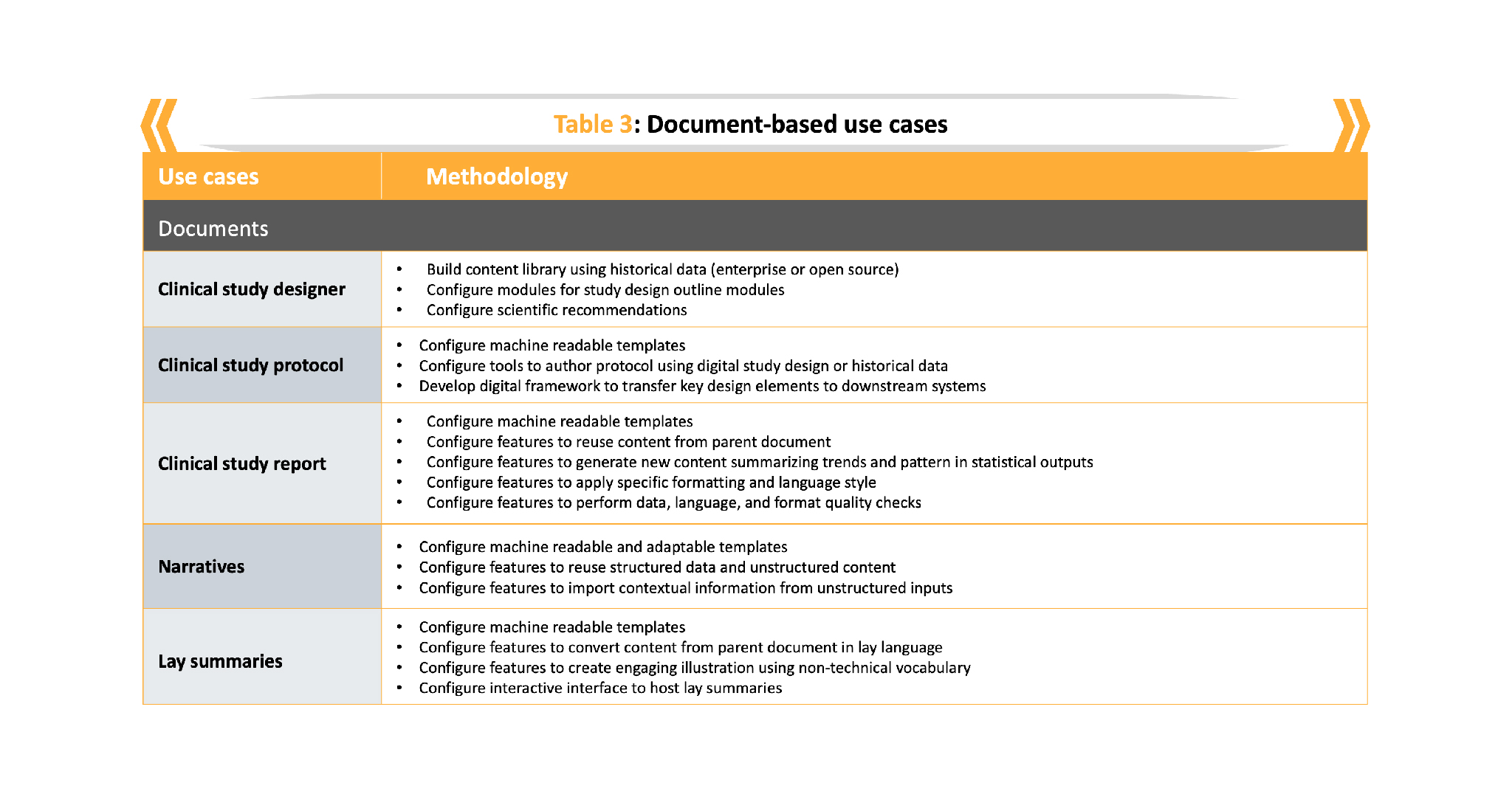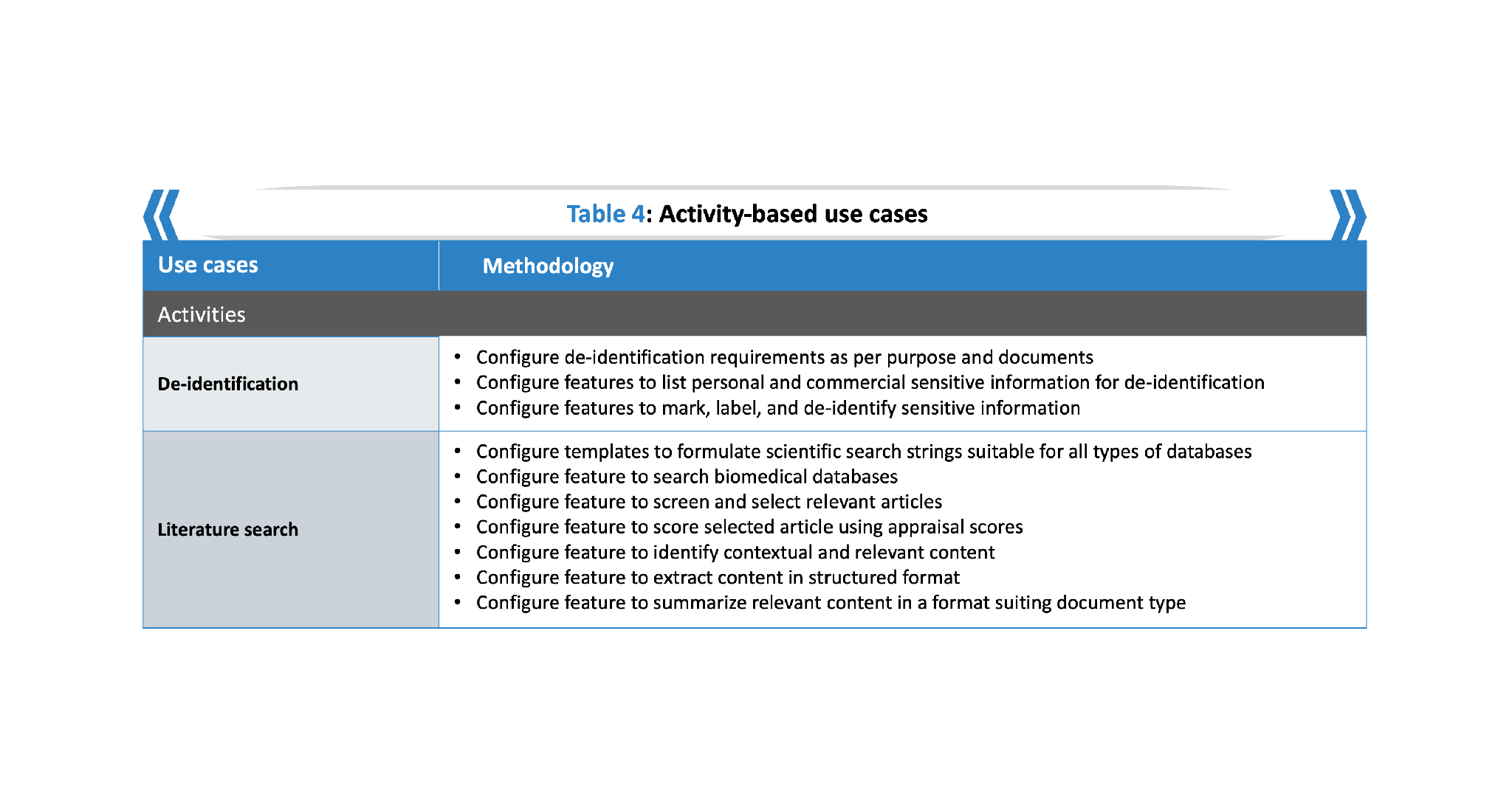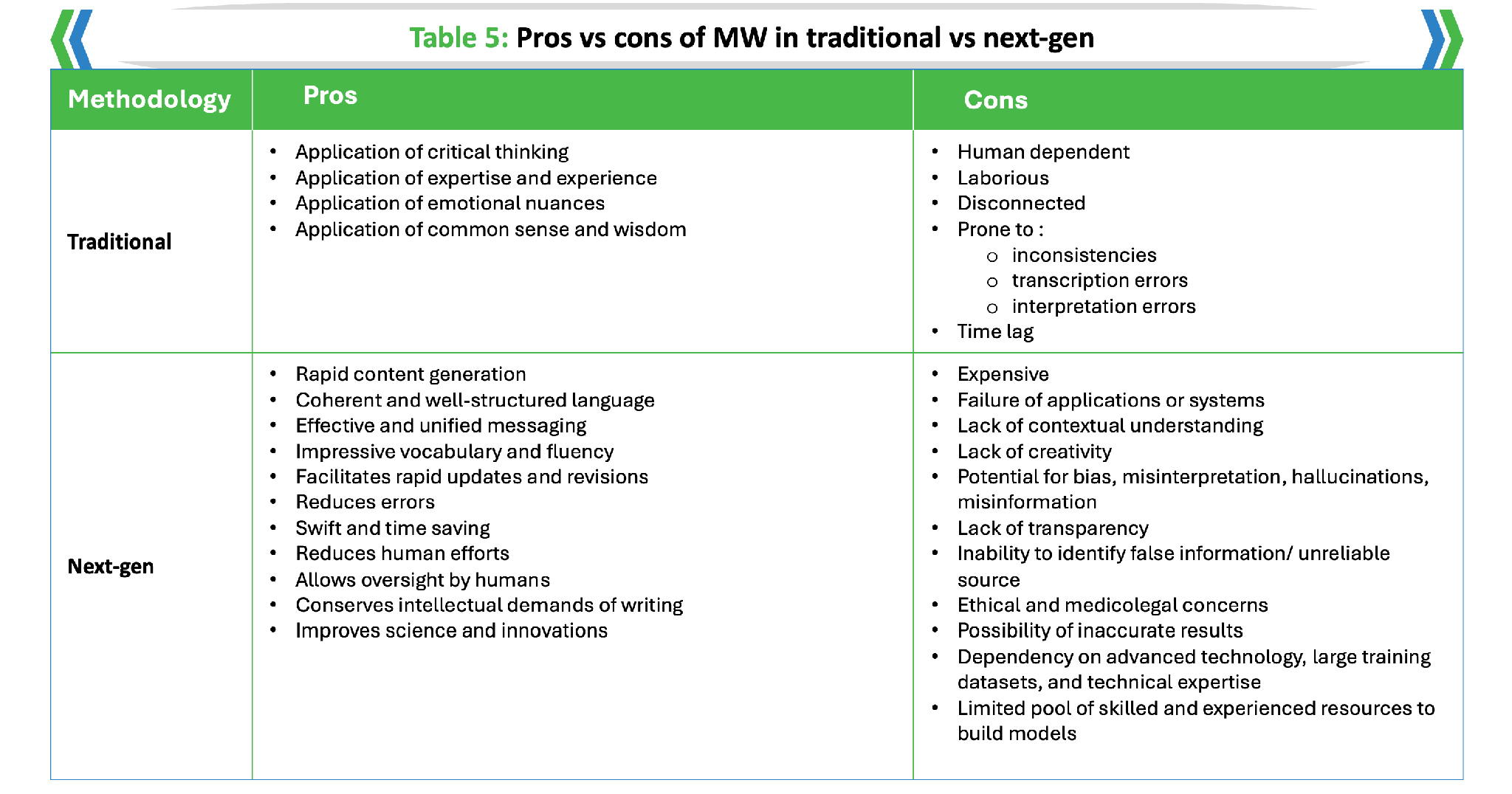Industry
Solution
Highlights
- Medical writing involves enhancing the accuracy, efficiency, and clarity of medical documentation to ensure effective communication and compliance with regulatory standards.
- The life sciences industry witnessed the exponential use of advanced computing technologies, such as artificial intelligence (AI) and machine learning (ML) in medical product development, which gained further momentum with the advent of generative AI (GenAI).
- The life sciences industry acknowledges AI's benefits in product development and therapies and is ready to adopt it with safeguards. AI streamlines medical writing by automating tasks and processes, saving time, cutting costs, and accelerating medical innovation to market.
On this page
Abstract
Medical writing is a crucial communication channel for sharing and preserving knowledge related to medical research and healthcare-generated information. The evolution of medical writing has been a transformative journey from pen and paper to AI-generated writing in today’s digital era. AI has redefined human-machine interactions by infusing cognitive capabilities into computing systems. Rapidly, the medical writing community acknowledged the far-reaching impact of AI and opened to exploring and using it. It is obvious, the future of medical writing will be powered by AI-enabled machines and applications that eventually will evolve from niche to mainstream. Each automated task implemented with AI or without AI will be a vital piece shaping the collective landscape of futuristic medical writing.
Introduction
Digital technologies have transformed the life sciences landscape, revolutionizing the entire spectrum from product discovery and clinical trials to pharmacovigilance, post-marketing surveillance, and clinical practice. It is a well-known fact that due to patient safety, data integrity, and security concerns, the medical, pharma, and healthcare industry has always been a cautious and late adopter of newer technologies, initiating their use in isolated pockets. On the contrary, over the recent years, the life science industry witnessed exponential use of AI and ML in product development, which gained further momentum with the advent of GenAI. GenAI emerged as the transformative tech trend in 2023, transforming how content is designed, drafted, and generated. AI, especially GenAI, is undoubtedly here to elevate medical writing, unlocking innovative possibilities for enhancing quality and collaboration.
Medical writing path
Over the decades, the world of writing has evolved along with advances in computing technology. Text editing software, document management systems, the internet, web, cloud computing, Internet of things (IoT), data analytics, and AI-driven solutions seamlessly reshaped how we create, consume, access, and disseminate content. In the medical writing space, Microsoft Word and Google Docs, with their intuitive and user-friendly interface, have been the primary work base for authoring, editing, and organizing content. The authoring experience improved with a steady influx of versatile features in word processors and specialized software for reference, graphics, collaboration, plagiarism, editing, and publishing. Standardization efforts led to the birth of common document templates instilling a consistent, harmonized, industry acceptable structure, language, and standards, improving communication across document and users. Steadily document-based templates matured into e-templates to support the reuse of content between specific document pairs, minimizing manual efforts. Online meeting software interlinked teams regardless of location and became a natural way to connect, converse, and collaborate in medical writing.
Most of the technological solutions for medical writing were process-oriented and document-centric, confined to a closed user base or a document type. Thereafter, considering the reuse of content across a pool of documents, the technological investments in medical writing shifted from document to content. Structured content management (SCM) systems were designed to create content once and use it often, marking the beginning of true automation in medical writing. Inclusion of semantic markers in SCM systems has helped to add context to the content, making it machine-readable. Use of biomedical terminologies and markup languages transitioned semantic authoring models into data-driven authoring models. As drug research thrives on data, data-driven insights have been found to complement and supplement the designing process of core documents such as clinical study protocols.
Long ago, AI was embedded into the computing systems assisting everyday writing via autocorrections, word suggestions, paraphrasers, summarizers, and language translators. With the release of Open AI ChatGPT in 2022, AI and its spectrum (NLP, ML, GenAI) became the transformative force disrupting the way we work and conduct business, especially in the information and content industry. The ability of AI spectrum to decode human language, process enormous content swiftly, learn from patterns, infer trends, and translate insights into tangible outcomes has numerous applications in medical writing.
AI in medical writing
It is often difficult for medical writers to find enough time to focus on crucial aspects of their work such as critical thinking, reviewing, and engaging in meaningful discussions around science. AI has the potential to make the job of medical writers more productive by automating various aspects of content development. An AI-enabled tool would help to search, screen, and select relevant scientific literature. The capability of such tools could be expanded to extract and gather specific data points for analysis or summarize the content. Similarly, the extractive function of AI would help to collect, standardize, and organize medical research concepts from diverse historical documents in a semantic machine-readable repository to discover new insights and experiment with new research designs. Digital libraries of clinical study concepts would facilitate development of clinical study protocol and the downstream systems and documents leveraging interoperable ecosystem for clinical studies. AI-based text generation models trained on multiple structured and unstructured domain specific data sources can be queried to generate contextual outlines, comparative analysis, and summaries as well as articulate data trends and patterns. AI solutions assisting research would help to converse with source files, comprehend complex information, evaluate references, match earlier work, annotate content, and much more. Peer review could be streamlined with AI tools performing checks to confirm compliance with reporting and submission process. AI model performing data, language, and formatting checks has potential to reform the traditional quality check activity into a few minutes’ digital procedure. The level of review and quality checks could be iteratively evolved from basic to advanced criteria.
AI-enabled strategies could be used to build point solutions addressing specific tasks or could become an integral part of a platform orchestrating the end-to-end medical writing process or could adopt an omnichannel framework providing access to all forms of AI-based automation tools and technique from a single platform. In-depth understanding of the medical writing standards, operating procedures, and guidelines followed by thoughtful assessment of the industry requirements and available resources would help to construct intelligent architecture, workflows, and tools. Table 1 reimagines the medical writing manual workflow with automation possibilities.
Automation use cases
The way the medical writing content is structured, drafted, and formatted is governed by the topic being discussed, research milestones, document intent, and the target audience. Considering these influences, medical writing discipline broadly falls into below three streams (Table 2) and automation for each of these groups requires customization for subtle requirements.
Automations for any stream of medical writing should aim to deliver precise foundational information which could be then moderated and optimized by medical writers, applying human insights, critical thinking, experience-based expertise, and emotional intelligence. Use cases with GenAI should be qualified judiciously after excluding other methodologies such as rule-based programming or traditional AI. Any form of automation including GenAI application should be considered as writing aid and not as a substitute for human author. A balance between realistic expectations and undue fear about AI would guide use of AI in areas that it excels, that are swift processing of massive diverse content. We present automation ideas for key deliverables of some medical writing streams (Tables 3 & 4):
Concerns
Along with efficiencies, AI, particularly GenAI, carries functional, operational, and compliance risks, which include inaccuracies, bias, misinformation, data privacy, lack of explainability, question on accountability, and threat to livelihood of mundane job roles. Apart from these evident concerns, many more unforeseen risks are likely to surface with more usage of AI in the real world and different domains (Table 5). Owing to critical concerns and risks associated with AI, it is important to stress that AI-generated content needs to be checked and validated by a human.
Guardrails
The concerns associated with AI could be overcome with counterbalancing measures, alternate options, continuous evaluation, and risk mitigation strategies. Risk management for AI solutions should define acceptable and unacceptable levels of risks and clarify appropriate - legal, quality, privacy, social, transparency, system, organization, and industry governed - guardrails. Ethical concerns with AI use in medical writing will require a thoughtful approach and practical guidelines. It is indeed difficult to retrospectively correct bias in solutions trained on data having toxic, bias, disproportionate, and inaccurate information. Prospective measures such as regular retraining with the latest knowledge and audit of algorithms will help to detect and prevent bias and misinformation. Use of technical metrics would help to quantify performance, trustworthiness, and risks of AI applications. Use of AI in medical writing should be made responsible and explainable with clear guidelines by policy makers, further supported by robust validation processes, consistent interactions between AI systems and human expertise, and acknowledgment of role and extent of AI use in documents. Additional vigilance, fact-check, and verification of source would be essential for AI-derived outputs. A human in loop strategy must be an integral and consistent mechanism to continuously correct and enhance decision making capabilities of AI solutions.
Since adaptive AI seamlessly infiltrated our general and specialized areas of work life, this progress went unnoticed leading to skills gap, lack of clarity on right use cases, and multiple risks. There is an ever-increasing fear that AI will replace humans leading to mass unemployment. This has resulted in a low to moderate level of readiness or resistance to automation opportunities possible with GenAI. It is important to acknowledge that AI will not eliminate the medical writer’s (MWs) role but drastically transform the way writers do their job. AI is an aid to process high and diverse data volume and generate content, and in the current status will not replace human critical thinking. Partnering of life science industry with innovative technology providers will help to address the specific needs of medical writing domain and design flexible solutions in a personalized manner. Technology providers, by leveraging the latest technology, expertise, experience, seamless support, risk management strategies, would help the life science business to launch or propel their tech transformation and be ready for future disruptions. Training and education would help to keep pace with the change and ensure a seamless transition into the new way of working. A merger of transformative technological expertise and life sciences intelligence to pilot AI-driven solutions would supercharge the present medical writing workflows.
Conclusion
The life sciences industry has acknowledged the substantial benefits of AI and GenAI in product development and targeted therapies and is ready to adopt AI with adequate guardrails. The use of AI has garnered fast followership across the medical writing domains to achieve process and content optimization. In the medical writing process, AI can be used to automate a multitude of operational and functional tasks. Ability of AI spectrum to understand human language, search sources, identify relevant content, extract the content, process text, and generate new text saves time which will eventually reduce cost and accelerate the time-to-market for medical innovations.
© Copyright [2024], Tata Consultancy Services Limited. All Rights Reserved. Document ID CGTC010552












